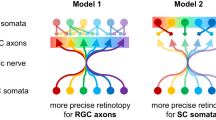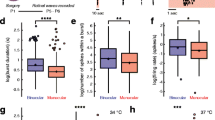Summary
Locally-correlated neural activity appears to play a key role in refining topographically mapped projections. The retinotectal projection of the goldfish normally regains a high degree of spatial precision after regeneration of a cut optic nerve, but it fails to do so if retinal ganglion cell activity is blocked by tetrodotoxin, or if local correlations in activity are masked by the synchronizing effect of stroboscopic light. A sharp retinal image is not normally needed for a sharp map because local correlation occurs even in darkness or diffuse light, but the possibility that a sharp image might restore local correlation and sharpen the map in stroboscopic light, though taken into account in earlier experiments, has not previously been tested. The precision of the retinotectal map was therefore studied, by retrograde transport of WGA-HRP from a standard tectal injection site and quantitative analysis of the labelled ganglion cell distribution, after regeneration of a cut optic nerve for 83–84 days in either continuous stroboscopic light or normal diurnal light. The lens of the eye was either ablated to blur the retinal image or sham-operated. Two different strobe flash patterns used in previous experiments were also compared. With the lens ablated, stroboscopic light impaired map refinement significantly, confirming previous results. A rapid, irregular flash pattern averaging about 5 Hz was rather more effective than a regular 1 Hz pattern. With the lens intact, however, neither pattern had any detectable effect. The significant gain in precision resulting from a sharp retinal image in these circumstances suggests that common mechanisms could underlie both the internal refinement of the retinotectal map and such directly experience-sensitive processes as the experimental realignment of binocular maps in the frog Xenopus, and of auditory and visual maps in the barn owl.
Similar content being viewed by others
References
Arnett DW (1978) Statistical dependence between neighbouring retinal ganglion cells in goldfish. Exp Brain Res 32: 49–53
Arnett DW, Spraker TE (1981) Cross-correlation analysis of the maintained discharge of rabbit retinal ganglion cells. J Physiol (Lond) 317: 29–47
Charman WN, Tucker J (1973) The optical system of the goldfish eye. Vision Res 13: 1–8
Chung SH (1974) In search of the rules for nerve connections. Cell 3: 201–205
Cook JE (1979) Interactions between optic fibres controlling the locations of their terminals in the goldfish optic tectum. J Embryol Exp Morphol 52: 89–103
Cook JE (1984) A simple pseudorandom interval generator. J Physiol (Lond) 357: 6P
Cook JE (1986) A sharp retinal image increases the precision of the regenerated goldfish retinotectal projection under stroboscopic conditions. J Physiol (Lond) 372: 84P
Cook JE (1987) Full spatial refinement of the regenerated goldfish retinotectal projection can occur in darkness, though not in diffuse stroboscopic light. Neurosci Lett 29 Suppl: S31
Cook JE, Rankin ECC (1984) An effect of stroboscopic light on the retinotopography of regenerated optic terminals in goldfish. J Physiol (Lond) 357: 23P
Cook JE, Rankin ECC (1986) Impaired refinement of the regenerated goldfish retinotectal projection in stroboscopic light: a quantitative WGA-HRP study. Exp Brain Res 63: 421–430
Cook JE, Rankin ECC, Stevens HP (1983) A pattern of optic axons in the normal goldfish tectum consistent with the caudal migration of optic terminals during development. Exp Brain Res 52: 147–151
Cowan WM, Hunt RK (1985) The development of the retinotectal projection: an overview. In: Edelman GM, Gall WE, Cowan WM (eds) Molecular basis of neural development. Wiley, New York, pp 389–428
Dubin MW, Stark LA, Archer SM (1986) A role for actionpotential activity in the development of neuronal connections in the kitten retinogeniculate pathway. J Neurosci 6: 1021–1036
Easter SS Jr, Stuermer CAO (1984) An evaluation of the hypothesis of shifting terminals in goldfish optic tectum. J Neurosci 4: 1052–1063
Gaze RM, Sharma SC (1970) Axial differences in the reinnervation of the goldfish optic tectum by regenerating optic nerve fibres. Exp Brain Res 10: 171–181
Ginsburg KS, Johnsen JA, Levine MW (1984) Common noise in the firing of neighbouring ganglion cells in goldfish retina. J Physiol (Lond) 351: 433–450
Harris WA (1980) The effects of eliminating impulse activity on the development of the retinotectal projection in salamanders. J Comp Neurol 194: 303–317
Horder TJ, Martin KAC (1982) Some determinants of optic terminal localization and retinotopic polarity within fibre populations in the tectum of goldfish. J Physiol (Lond) 333: 481–509
Johnsen JA, Levine MW (1983) Correlation of activity in neighbouring goldfish ganglion cells: relationship between latency and lag. J Physiol (Lond) 345: 439–449
Keating MJ, Grant S, Dawes EA, Nanchahal K (1986) Visual deprivation and the maturation of the retinotectal projection in Xenopus laevis. J Embryol Exp Morphol 91: 101–115
Knudsen EI (1985) Experience alters the spatial tuning of auditory units in the optic tectum during a sensitive period in the barn owl. J Neurosci 5: 3094–3109
Lewis D, Teyler TJ (1986) Long-term potentiation in the goldfish optic tectum. Brain Res 375: 246–250
Mastronarde DN (1983) Correlated firing of cat retinal ganglion cells. I. Spontaneously active inputs to X-and Y-cells. J Neurophysiol 49: 303–324
Meredith MA, Stein BE (1986) Spatial factors determine the activity of multisensory neurons in cat superior colliculus. Brain Res 365: 350–354
Meyer RL (1983) Tetrodotoxin inhibits the formation of refined retinotopography in goldfish. Dev Brain Res 6: 293–298
Rankin ECC, Cook JE (1986) Topographic refinement of the regenerating retinotectal projection of the goldfish in standard laboratory conditions: a quantitative WGA-HRP study. Exp Brain Res 63: 409–420
Rodieck RW (1967) Maintained activity of cat retinal ganglion cells. J Neurophysiol 30: 1043–1071
Sanes DH, Constantine-Paton M (1985) The sharpening of frequency tuning curves requires patterned activity during development in the mouse, Mus musculus. J Neurosci 5: 1152–1166
Schmidt JT (1985) Formation of retinotopic connections: selective stabilization by an activity-dependent mechanism. Cell Mol Neurobiol 5: 65–84
Schmidt JT, Edwards DL (1983) Activity sharpens the map during the regeneration of the retinotectal projection in goldfish. Brain Res 269: 29–39
Schmidt JT, Eisele LE (1985) Stroboscopic illumination and dark rearing block the sharpening of the regenerated retinotectal map in goldfish. Neuroscience 14: 535–546
Schmidt JT, Tieman SB (1985) Eye-specific segregation of optic afferents in mammals, fish and frogs: the role of activity. Cell Mol Neurobiol 5: 5–34
Siegel S (1956) Nonparametric statistics for the behavioral sciences. McGraw-Hill, Tokyo, pp 184–194
Stiles M, Tzanakou E, Michalak R, Unnikrishnan KP, Goyal P, Harth E (1985) Periodic and nonperiodic burst responses of frog (Rana pipiens) retinal ganglion cells. Exp Neurol 88: 176–197
Udin S (1985) The role of visual experience in the formation of binocular projections in frogs. Cell Mol Neurobiol 5: 85–102
Whitelaw VA, Cowan JD (1981) Specificity and plasticity of retinotectal connections: a computational model. J Neurosci 1: 1369–1387
Willshaw DJ, Malsburg C von der (1976) How patterned neural connections can be set up by self-organization. Proc R Soc (Lond) B 194: 431–445
Wye-Dvorak J, Marotte LR, Mark RF (1979) Retinotectal reorganization in goldfish. I. Effects of season, lighting conditions and size of fish. Neuroscience 4: 789–802
Yoon MG (1975) Effects of postoperative visual environments on reorganization of retinotectal projection in goldfish. J Physiol (Lond) 246: 673–694
Author information
Authors and Affiliations
Rights and permissions
About this article
Cite this article
Cook, J.E. A sharp retinal image increases the topographic precision of the goldfish retinotectal projection during optic nerve regeneration in stroboscopic light. Exp Brain Res 68, 319–328 (1987). https://doi.org/10.1007/BF00248798
Received:
Accepted:
Issue Date:
DOI: https://doi.org/10.1007/BF00248798




